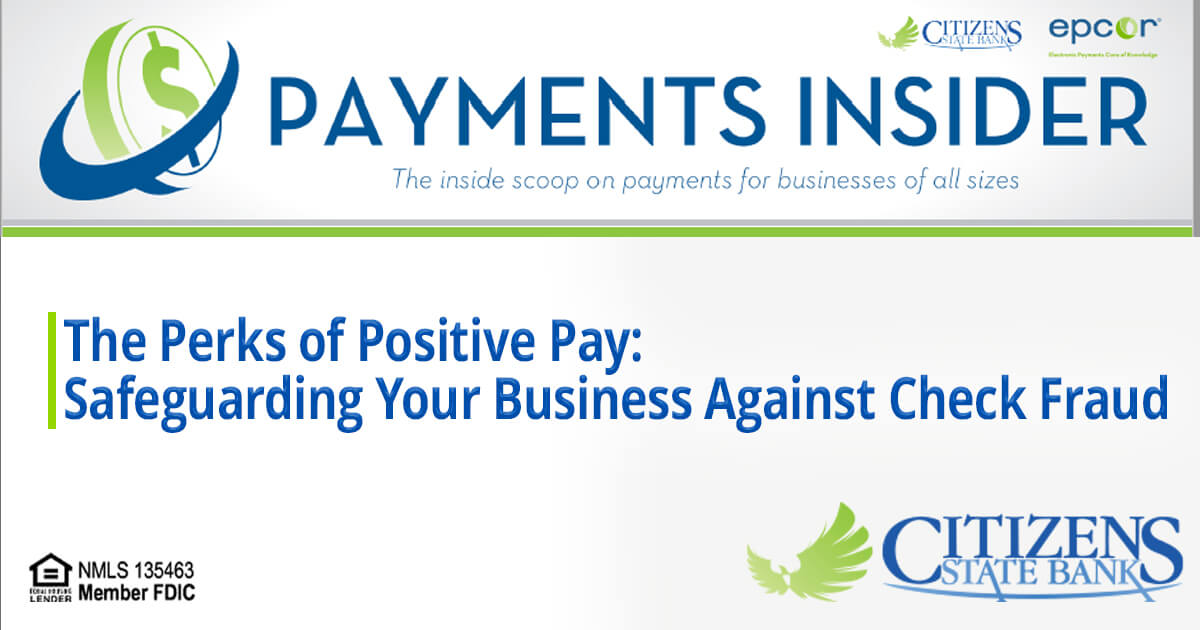November 7, 2023 •Trevor Witchey, AAP, NCP, Senior Director, Payments Education, EPCOR

November 7, 2023 •Trevor Witchey, AAP, NCP, Senior Director, Payments Education, EPCOR

In an era when digital payment methods are gaining popularity, traditional check payments still dominate business transactions. However, the security risks associated with check transactions pose a significant concern for businesses that frequently utilize checks. The prevalence of checks provides an opportunity for fraudsters to create and pass counterfeit checks, resulting in substantial financial losses. As a responsible business owner, it is essential to take measures to protect your company from such criminal activities.
So, what can your financial institution do to help mitigate check fraud? Enter positive pay—a powerful tool that enhances the security of your check transactions. If you’re unfamiliar with positive pay, it is a type of automated fraud detection technology designed to detect and prevent counterfeit checks. By leveraging this service, you can add an extra layer of security to safeguard your business. Reach out to your financial institution today to inquire if they offer positive pay services.
Positive pay operates through a meticulous examination of checks presented for payment, comparing them against the initial company-issued checks. The system scrutinizes various check features, such as the amount, check number and payee name, to identify suspicious items or discrepancies.
There are several positive pay variations that can be employed. Let’s explore some of them:
To shed light on the benefits of positive pay, let’s explore a couple of real-life scenarios encountered by companies:
Experience 1: An ex-employee of a company utilized the account information at the bottom of their payroll check to create counterfeit checks. The ex-employee issued these counterfeit checks to various acquaintances who subsequently cashed them at multiple branches. Unfortunately, the company had not implemented the positive pay system offered by their financial institution, and it took them several months to discover the fraud. Total Company Loss: $3,261.27
Experience 2: A business customer paid a vendor $3,000 for parts. However, the Accounts Receivable person left the check on their desk during their lunch break, allowing another employee of the vendor to record the MICR line information from the business customer’s check. This unscrupulous employee then created counterfeit checks on the business customer’s account to pay off their personal student loans and car loans, totaling $300,000. Fortunately, the business customer had wisely opted for the positive pay service provided by their financial institution.
This service not only verified the dollar amount and check number but also cross-referenced the payee names. Consequently, when the counterfeit checks were presented for payment, they were promptly identified as fraudulent by the positive pay system. Their financial institution immediately contacted the business, and the counterfeit checks were returned as “counterfeit.” Total (Potential) Loss: $300,000.00
The second example vividly illustrates how the implementation of positive pay saved the business from significant financial loss. By utilizing positive pay, the business ensured advanced security for their check transactions. Although check fraud is not uncommon in the United States, companies that heavily rely on check payments can significantly mitigate risks by leveraging protective services like positive pay.
To ensure the effectiveness of your positive pay system and prevent or minimize losses, it is crucial for businesses to maintain accurate records of their check payments. By doing so, you can enhance the security of your transactions and instill peace of mind.
Take proactive steps today by reaching out to your financial institution to inquire about their positive pay service and determine whether its implementation is right for your business. Safeguard your company against check fraud and embrace the perks of positive pay.
The views, information, or opinions expressed in this article are solely those of the author and do not necessarily represent the views of Citizens State Bank and its affiliates, and Citizens State Bank is not responsible for and does not verify the accuracy of any information contained in this article or items hyperlinked within. This is for informational purposes and is no way intended to provide legal advice.